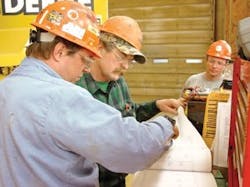The Psychology of Electrical-Problem Diagnosis and Repair
“Yes, nothing gets the taste of shame and humiliation out of your mouth quite like a piece of Be-Bop-A-Re-Bop Rhubarb Pie.”
So says Garrison Keillor, host of the Saturday night radio show, Prairie Home Companion, “sponsored” by such “businesses” as Be-Bop-A-Re-Bop and Ralph’s Pretty Good Grocery. The above tag line for the Be-Bop-A-Re-Bop “commercial” always comes after Keillor tells a story about a hapless soul—like the guy who spills coffee on his pants while waiting for a job interview, and when he removes his trousers in the men’s room to dry them, they’re somehow sucked out the second-story window. “Wouldn’t this be a good time for a piece of Be-Bop-A-Re-Bop Rhubarb Pie?”
Maybe we need to keep a Be-Bop-A-Re-Bop Rhubarb Pie in the shop fridge, because good technicians, doing their best to run down electrical faults in expensive earthmovers, often are made to feel as if they’re incompetent time-wasters when repeatedly asked those dreaded questions: “So, what’s wrong?” and “How long will it be?”
Maybe a slice of Be-Bop-A-Re-Bop would help restore the technician’s shattered self-confidence at this point. Or, better yet, maybe it’s time to build up the technician’s self-confidence by taking a fresh approach to the process of electrical-problem diagnosis and repair—an approach to avoid this frustrating and annoying ordeal for the technician and, ultimately, to promote proper, long-lasting repairs.
Electricity versus gears
The diagnosis of mechanical problems usually—not always, but usually—is a straightforward process accomplished in a reasonably quick time. A broken hose is pretty obvious. Repairing these mechanical faults, however, might take hours or days. But no matter, because during the process of investigating and repairing mechanical faults, no one is upset; everyone can relate to—and appreciate—the entire process and can see progress.
On the other hand, diagnosing electrical problems usually—not always, but usually—requires quite a long time, but the ensuing repair typically requires only a short time. Even though we really do understand that this is the truth, if the technician is continually asked the “what’s wrong?/how long?” questions during the process, everyone gets frustrated.
As a consequence, the diagnostic process can drag out even more. Or, the technician, now angry and questioning his technical abilities, tries to get around the real problem by using blue wire and toggle switches to substitute for factory wiring. That’s why you end up with expensive equipment breaking down all the time.
New attitudes all around
If everyone involved recognized that the “what’s wrong?/how long?” questions are unanswerable and degrading to a good mechanic, then life would be easier and electrical repairs would be made properly in reasonable time. If everyone understood that the process of diagnosing electrical problems is fundamentally different from diagnosing mechanical problems, then we’d stop “short-circuiting” electrical diagnosis.
Of course, technicians are not completely without error here. They can add to the general frustration that surrounds electrical diagnosis and repair by forgetting a basic principle: A.S.S.S.—Always Something Super Simple. The technician must remember from the very start that, in the end, the actual fault will be something insanely simple. But no matter how often they experience this truth, many technicians resist the idea that a rusty ground can and will shut down a $2-million machine.
Since there’s something for everyone to learn here, let’s pick on the shop supervisor next. Supervising the electrical-problem-diagnosis process requires a special touch. The supervisor must be willing to give time to do the job properly, to allow for errors, and to defend the technician when the customer is jumping up and down.
This is especially true in the field. Field-service technicians shouldn’t have to defend their actions to uninformed customers, but they’re forced to do it every day. If management would run interference and take the heat off of the technician, the situation could be defused and the repair process would go faster. This problem is becoming less apparent as more customers buy computerized machines, but it still does occur, and it still makes for an angry technician when it does.
As a training tool, the supervisor must have the patience to create an effective working space that allows technicians to work problems through to completion, to recognize the technical reason for the failure, and, finally, to understand why the fault caused a particular failure. If technicians are not permitted to think through the process, free from unreasonable time constraints, they’ll never learn—and things will never change.
Disclaimer of sorts
Keep in mind as you read the following “diagnostic protocol” draft that it’s one guy’s opinion about how things could be made better. But it’s an opinion based on 30 years of observing actual electrical-diagnosis situations in real shops. So give it a read; whether you agree or disagree, I’d welcome your comments—[email protected].
Still, when you propose something different, you have an uneasy feeling that you might be a lone voice in the wilderness. So I asked several people I’ve worked with over the years to review my ideas—people I knew would give me a straight answer. Yes, as it turns out, using their comments is self-serving, but it was important for me to know that I wasn’t completely out in left field.
From Charles Craft, product support technical specialist with Leslie Equipment in W.Va.: “Deere has a seven-step diagnostic procedure similar to what Dan is suggesting, and it works. In my experience—and as Dan suggests—a critical point in diagnostics is understanding what you’re working on—Deere calls it ‘know the system.’ Do that, and you’re halfway home. I agree, too, with the psychological impact that these problems can have on technicians—and if they think they’re under time constraints, it’s multiplied.”
From Bob Hoster, recently retired after a career at Caterpillar that included 17 years as primary training consultant and subject matter expert on engines and engine electronics:
“Dan and I have had discussions over the years about the subject of this article and how to change the industry’s approach to the diagnosis of electrical problems. A big issue in recent years has been one of the points of the article—convincing technicians that 80 to 90 percent of the time, the problem ends up being something simple.”
Diagnosis Protocol: Phase 1
The electrical-problem-diagnosis process usually is initiated by an operator complaint. The critical first step is to pin down the operator about specifics, because some complaints are based on vague impressions that “something’s wrong” or vague statements like “I think it might be an electrical problem.” It’s not fair to pass along this kind of unsubstantiated information to the technician responsible for the repair.
So, have a qualified, clear-thinking person write the service order as the operator is questioned about the complaint. Split the service order into three sections:
Section 1 is for facts only—information that is known to be absolutely correct;
Section 2 is for assumptions and opinions—–if the operator or supervisor has an opinion about the nature of the fault, list that here, but do not present opinions as facts. And since I’m being honest here, I’ve yet to find any “advice and predictions” from dispatchers that actually proved helpful to the technician.
Section 3 lists potentially relevant events in the machine’s history (operating incidents, recent repairs or maintenance) that might have a bearing on the complaint at hand, especially if a similar machine in the fleet experienced the problem.
Okay, okay, we realize we’re suggesting that you take maybe 30 minutes to write the service order, a long time compared with writing most service orders. But the point is, if you get it right from the start, you could potentially save hours in the long run by keeping the process on track and focused. (Think of electrical repairs that have gone on for days, or weeks; that might motivate you to take time writing the order.)
Next, make sure technicians have all the appropriate technical information that might be helpful in diagnosing the problem, including machine service manuals, wiring schematics or service bulletins that might be relevant. Make it clear to technicians that these are valuable tools that should be used.
Allow adequate time for technicians to review the material in order to get a fundamental understanding of how the system works—and don’t be critical if they take an hour or so to do their research. Without knowing how the system works, the repair will be far more difficult to complete correctly and in a timely manner. Let’s say that again: If you don’t understand how the system is supposed to work, then the diagnostic process is flawed from the start.
So, how much time are we talking about here to successfully make the diagnosis of an electrical problem? Tough question, but let’s say at least four hours, which typically will be followed by probably a 10-minute repair. But along the way, everyone must keep in mind the fundamental difference between electrical and mechanical repairs, and so reminded, keep their mouths shut.
Don’t put the technician in the position of needing to predict an answer, and then deal with the ego problems of having to defend the prediction if it’s off the mark. That kind of pressure is unnecessary and destructive to the process.
Diagnosis Protocol: Phase 2
The technician should begin the diagnostic investigation by first trying to eliminate as many basic systems as possible that are functioning properly. There are many places and ways any one system can fail, but there’s only one way it works correctly. Don’t ask what’s wrong, ask what’s right.
Now, think about the overall systems that seem not to be functioning properly. Can you absolutely narrow the problem down to one system? If so, don’t jump in and start experimenting. Don’t do any repair work until you have compiled a complete list of faults that appear to be present in the system. Since at least 80 percent of all faults are wiring-related, changing parts will never be an effective method of diagnosis.
Next, start identifying the circuits within the malfunctioning system, using schematics to determine how they’re supposed to work. Begin by asking yourself basic questions: “What’s right in the suspect circuits?” “What’s wrong in the suspect circuits?” “What fault is most likely to be the cause?” “Is there an indication at this point about the exact problem?” Repeat the process as you move from systems, to circuits to components. The first question will always be, “What’s right?”
When you hit a snag or become confused by a finding or meter reading, return to the basic questions to avoid being side tracked. As you reconfirm your findings, don’t be afraid to trust your gut hunches.
If you decide that a particular fault is likely to be in a particular location, don’t move away from that area until you’re 100 percent convinced you’re right or wrong. If you you’re wrong, then your prediction should to be added to the list of items that are “right.”
But the caution here is not to conclude too hastily that the fault is not where you’re convinced it is. Remember, gut hunches can be valuable. At this point, it’s extremely important that a second set of eyes be given the chance to look over the suspect area and search for the fault.
As you proceed, avoid taking excessive meter readings, unless you have a plan of attack and a good idea of what reading you should get at a particular spot. Use the voltmeter, primarily, and make sure you understand the resulting readings. Taking too many readings without knowing what to expect at a particular point adds to the confusion.
In other words, don’t use meter reading as a way to kill time if you don’t have a clear idea of what to do next. Don’t underestimate the damage this feeling will do not only to the diagnostic process, but also to your psyche.
Be decisive about which systems you’ve determined to be functional, and resist the urge to work on systems that aren’t failed. And again, limit the number of tests and meter readings to just those that are relevant.
Diagnosis Protocol: Phase 3
As the diagnostic process continues, don’t hesitate to ask questions of others, for instance, “How exactly does this component operate?” Don’t be hesitant to bounce ideas and theories off other people about the potential cause of the fault. Resist the temptation, however, to make specific predictions about identifying the problem, and avoid any attempt to defend yourself.
Again, always keep in mind that 80 to 90 percent of all electrical faults are “no-brainers” to repair: one wire, one terminal, one ground, and the like. Don’t assume that this fault is not simple, and that this is the one time it will be a catastrophic failure with meltdown and shrapnel. Keep the process moving by focusing on the diagnostic process—not the repair—and by doing all you can to keep all parties involved likewise focused.
With that advice in mind, remember to keep track of findings by writing down your plan, the process and outcomes. Why do the work twice? If you find a problem and have all the research recorded, especially in a fleet, then it never has to be repeated. This works to your advantage, because most machines have identical systems and wiring.
And for the supervisor, remember never to do or say anything that would lead the technician to believe that the diagnosis is taking too long. And, please, don’t ask the technician to estimate the length of time the diagnostic process might require. Assume four hours at first, and don’t get involved before then.
When you do get involved, avoid criticism; offer assistance, not harsh or critical comments, which will only make the eventual repair less effective. Remember that the repair will teach little; only the diagnostic process can really teach. If the opportunity to learn from the diagnostic experience is wasted, then the troubleshooting process will never shorten over time.
One more bit of advice for the technician. Although it might add 20 minutes to the job, make sure that wires and terminals are clean and tight, wires marked, wire ties and clips replaced, and that obvious mechanical hazards are corrected, such as sharp edges, abrasion points or corrosion. (High-temperature silicone caulk makes instant grommets that prevent rubbing and abrasion.) Good housekeeping during electrical repair can prevent future downtime.





